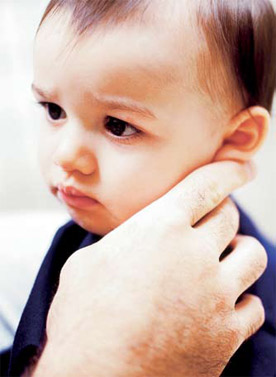Inflammation in the middle ear is known as otitis media. It usually occurs as a result of colds, sore throats or breathing difficulties. It can be of bacterial or viral origin.
According to a report by the Malaysian Health Technology Assessment (MaHTAS) group, under the Medical Programme by the Ministry of Health, Malaysia, at least 500,000 cases of otitis media occur annually in children less than two years old. Fifty percent are due to pneumococcus. It is estimated that 75% of children experience at least one episode of otitis media by the time they reach three years of age.
Otitis media can cause severe pain and starts with fever and runny nose. If untreated, it could lead to serious complications, including permanent hearing impairment due to the presence of fluid in the middle ear for extended lengths of time.
Types of Otitis Media
Otitis media can be divided into three types:
- Acute Otitis Media (AOM) – Fluid, typically pus, is found in the middle ear. Your child may experience pain, fever, redness of the eardrum, and irritability.
- Otitis Media with Effusion (OME) – This is more common than AOM, and the presence of fluid in the middle ear is only temporary. This fluid is not necessarily infected.
- Chronic Suppurative Otitis Media – This occurs when fluid is in the middle ear lingers for at least six weeks, and is considered a more chronic form of otitis media.
Causes
Bacteria such as Streptococcus pneumoniae, Haemophilus influenzae and Moraxella catarrhalis are the most common causes of otitis
Does My Child Have Otitis Media?
If your child is too young to speak, look for these signs to detect if he may have otitis media:
- Cries more often for no apparent reason.
- Tugging or pulling at one or both ears.
- Has difficulty in sleeping.
- Not responsive to soft sounds.
- Appears to be inattentive at school.
- Dizziness.
- Loss of balance.
Preventive Measures
To prevent your child from getting infected, here are several actions that can be undertaken:
- Breastfeed your child. Breast milk contains antibodies that protect your child from many illnesses and infections. Continue for up to two years or beyond to build up early immunity.
- Avoid exposure to cigarette smoke. Research shows passive smoking can increase the adherence of bacteria to the respiratory passages and depress the immune system, increasing the frequency and severity of ear infections.
- Practise good hygiene. Cultivate good hygiene habits such as frequent hand washing to prevent transmission of germs that can directly or indirectly cause ear infections.
- Get early treatment for the common cold and insist that your doctor look at your child’s eardrums.
Another effective way to protect your child from otitis media is through immunisation. Studies show that the frequency of otitis media among children was considerably reduced in those who had completed their immunisation series. (Weekly Epidemiological Record, 2007 – World Health Organisation)
Haemophilus influenzae type b (Hib) vaccine – This offers protection against diseases like pneumonia, meningitis and otitis media. It is available as a combination vaccine that protects against Hib, diphtheria, tetanus, and pertussis (whooping cough). Available since 2002, it has been included in Malaysia’s National Immunisation Programme.
Pneumococcal conjugate vaccine (PCV) – This guards your child from pneumococcal infections, including otitis media, bacteraemia and sinusitis. It consists of inactivated forms of 7 or 10 different serotypes of the bacteria, protecting against pneumococcal infections.
These strains are responsible for most severe pneumococcal infections among children. PCVs have lowered the number of severe pneumococcal disease by nearly 80% among children under five (Centres for Disease Control and Prevention, CDC, America) in the US where this vaccine is routinely given to all children. Currently an optional vaccine in Malaysia, PCV can be obtained in private hospitals or clinics.
The new 10-valent conjugate vaccine covers up to 10 different strains of pneumococcus, and the vaccine is recently available in Malaysia since October 2009.
For more up-to-date information regarding immunisation and the vaccines, consult your doctor.






Comments